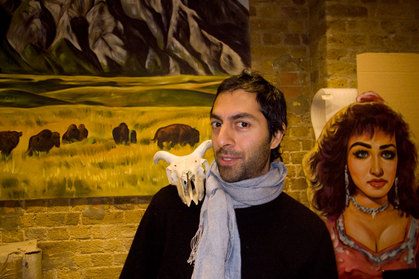-
From Issue 63
-
- Editor’s Letter In and out of this world
- News Yoshitomo Nara Arrested For Graffiti In New York Subway
- News Art Fraud Case Grips Autralia
- News Ibrahim Hussein (1936–2009)
- Essays Tino Sehgal
- Profiles Nalini Malani
- Features Singapore & Thailand Pavilions
- Features Pak Sheung Chuen
- Reviews Traces of Siamese Smile
- Reviews Su-Mei Tse
- Reviews Aperture 27,000
- Reviews Serkan Özkaya
- Projects Shezad Dawood
- Table of Contents
- Web Exclusives
- Archive
- Subscribe

R
E
V N
E
X
T
On the eve of the Tate Triennial, Shezad Dawood is reading the free tabloid thelondonpaper in his studio in London’s bohemian East End. He is amused to find himself on a Who’s Who list defining this decade’s new art. This freshly minted movement is the focus of this year’s Tate Triennial—the London equivalent of the New York’s Whitney Biennial—curated by Nicolas Bourriaud, who has dubbed the tendency and his show at the Tate Britain, “Altermodern.”
As Dawood shows me the article on the ping-pong table that also functions as his worktable, he admits bashfully, “My assistant found the paper on the seat of the London Tube and brought it to work.” Together we read “Know Your Modernisms,” an inset quasi-cheat sheet that begins with modernism and moves through postmodernism (“Warhol, Hirst, Koons”) and concludes with Altermodernism: “Gupta, Bob and Roberta Smith, Dawood. In a nutshell: A new optimism, where artists translate between cultures in a global network. Includes Anon-Western [sic] art and influences.” He laughs awkwardly.
Despite Dawood’s self-effacing reaction to the article, the tabloid newspaper fits perfectly in his studio. Although he received an MFA in 2000 for critical fine art practice at London’s Royal College of Art, Dawood appropriates popular culture from films to music, food and plastic toys as in his large Karachi-style sign-board paintings of local blockbuster movies or his neon signs of texts from the Quran nestled in dried tumbleweed.
The London-born artist of Indian and Pakistani descent is fascinated with notions of identity, whether cultural, ethnic or religious, depicted through the lens of popular culture. His own collections of pop ephemera share space in his studio with his art. In one corner is a handful of toys from the satirical cartoon series The Simpsons, which Dawood enjoys, particularly the Indian character Apu Nahasapeemapetilon. In another is Dawood’s record album collection of Bollywood hits and 1980s pop classics which, assembled over two decades, occupies one half the length of his studio wall along with two professional disc jockey turntables.
Adjacent to the records is a photograph in a lightbox, The Leader, with which he launched his artistic career in 2002. In this nearly two-meter-tall photograph Dawood assumes the persona of Oswald Ernald Mosley, the conservative politician who founded the British Union of Fascists. He dons a black military uniform with the Union Jack flag flying majestically in the background.
What excites Dawood the most, though, is the art-world premiere in February of his new film, Feature (2007–08), during the Tate Triennial. Dawood’s preoccupation with trying to both understand and confuse cultural histories collides in this nouvelle vague-style movie. In the summer of 2007, he moved from London to rural Cambridgeshire with some friends, including Jimmie Durham, a Cherokee Native American and legendary political activist and artist. There, Dawood filmed a zany American western starring Chief Crazy Horse, Lord Krishna, a valkyrie opera singer and a few zombie cowboys. Dawood was not just the scriptwriter and film director, he also played one of the leading roles, the beloved blue-skinned Hindu god Krishna, and he hand-painted the film’s scenic backdrops of western landscapes based on vintage picture books about the Old West, some featuring grizzly bears and others a herd of buffalo or a cactus under a pink sunset. While the film stands a chance of becoming a cult classic, it’s unlikely to score at the box office. However, some of the canvases he made for the film’s backdrops, a series he calls the “Great Outdoors” (2007), also double as individual paintings, and are likely to be coveted by curators and collectors alike.



